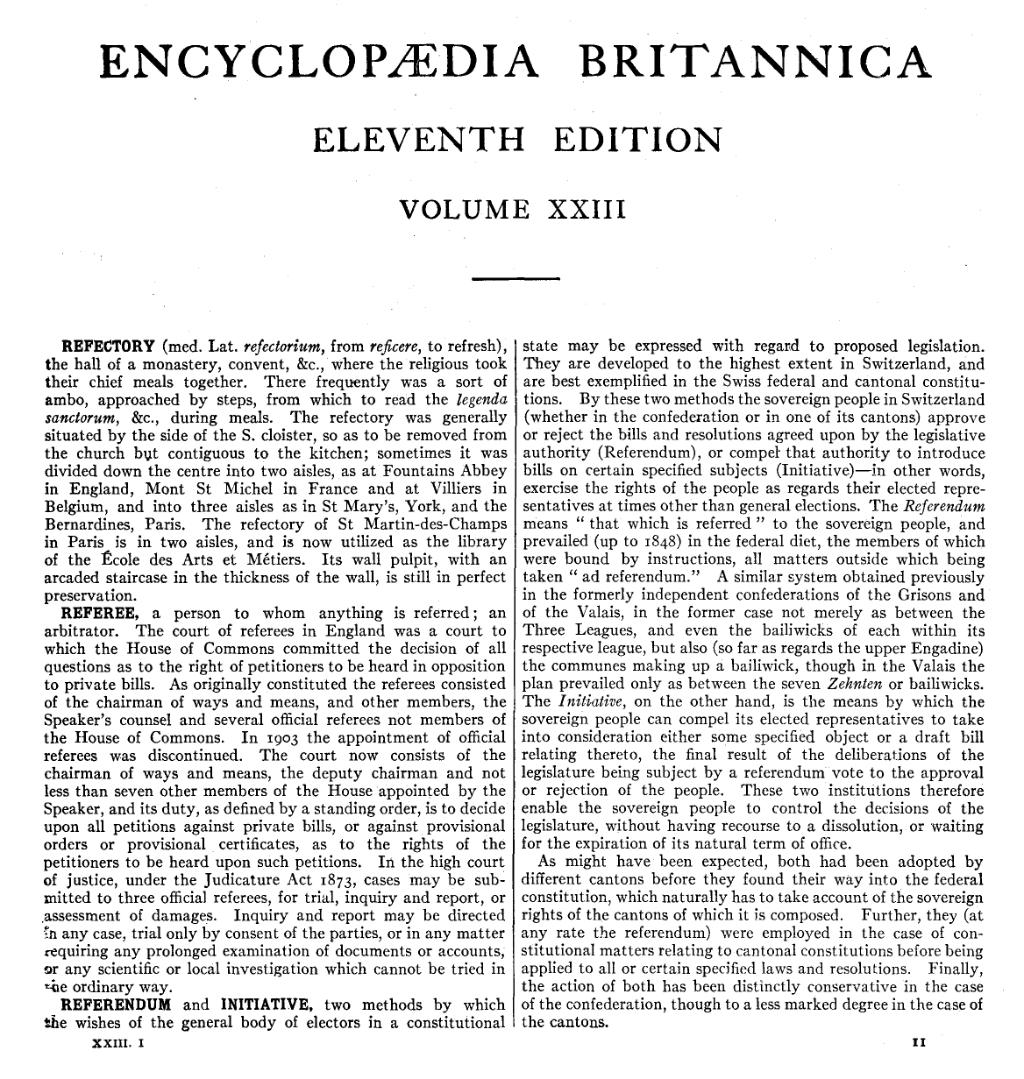ENCYCLCPÆDIA BRITANNICA
ELEVENTH EDITION
VOLUME XXIII
REFECTORY (med. Lat. refeclorium, from reficere, to refresh), the hall of a monastery, convent, &c., where the religious took their chief meals together. There frequently was a sort of ambo, approached by steps, from which to read the legenda sanctorum, &c., during meals. The refectory was generally situated by the side of the S. cloister, so as to be removed from the church but contiguous to the kitchen; sometimes it was divided down the centre into two aisles, as at Fountains Abbey in England, Mont St Michel in France and at Villiers in Belgium, and into three aisles as in St Mary's, York, and the Bernardines, Paris. The refectory of St Martin-des-Champs in Paris is in two aisles, and is now utilized as the library of the École des Arts et Métiers. Its wall pulpit, with an arcaded staircase in the thickness of the wall, is still in perfect preservation.
REFEREE, a person to whom anything is referred; an
arbitrator. The court of referees in England was a court to
which the House of Commons committed the decision of all
questions as to the right of petitioners to be heard in opposition
to private bills. As originally constituted the referees consisted
of the chairman of ways and means, and other members, the
Speaker's counsel and several official referees not members of
the House of Commons. In 1903 the appointment of official
referees was discontinued. The court now consists of the
chairman of ways and means, the deputy chairman and not
less than seven other members of the House appointed by the
Speaker, and its duty, as defined by a standing order, is to decide
upon all petitions against private bills, or against provisional
orders or provisional certificates, as to the rights of the
petitioners to be heard upon such petitions. In the high court
of justice, under the Judicature Act 1873, cases may be submitted
to three official referees, for trial, inquiry and report, or
assessment of damages. Inquiry and report may be directed
in any case, trial only by consent of the parties, or in any matter
requiring any prolonged examination of documents or accounts,
or any scientific or local investigation which cannot be tried in
the ordinary way.
REFERENDUM and INITIATIVE, two methods by which the wishes of the general body of electors in a constitutional state may be expressed with regard to proposed legislation.
They are developed to the highest extent in Switzerland, and
are best exemplified in the Swiss federal and cantonal constitutions.
By these two methods the sovereign people in Switzerland
(whether in the confederation or in one of its cantons) approve
or reject the bills and resolutions agreed upon by the legislative
authority (Referendum), or compel that authority to introduce
bills on certain specified subjects (Initiative)—in other Words,
exercise the rights of the people as regards their elected representatives
at times other than general elections. The Referendum
means “that which is referred” to the sovereign people, and
prevailed (up to 1848) in the federal diet, the members of which
were bound by instructions, all matters outside which being
taken “ad referendum.” A similar system obtained previously
in the formerly independent confederations of the Grisons and
of the Valais, in the former case not merely as between the
Three Leagues, and even the bailiwicks of each within its
respective league, but also (so far as regards the upper Engadine)
the communes making up a bailiwick, though in the Valais the
plan prevailed only as between the seven Zehnten or bailiwicks.
The Initiative, on the other hand, is the means by which the sovereign people can compel its elected representatives to take into consideration either some specified object or a draft bill relating thereto, the final result of the deliberations of the legislature being subject by a referendum vote to the approval or rejection of the people. These two institutions therefore enable the sovereign people to control the decisions of the legislature, without having recourse to a dissolution, or waiting for the expiration of its natural term of office.
As might have been expected, both had been adopted by different cantons before they found their way into the federal constitution, which naturally has to take account of the sovereign rights of the cantons of which it is composed. Further, they (at any rate the referendum) were employed in the case of constitutional matters relating to cantonal constitutions before being applied to all or certain specified laws and resolutions. Finally, the action of both has been distinctly conservative in the case of the confederation though to a less marked degree in the case of the cantons.
